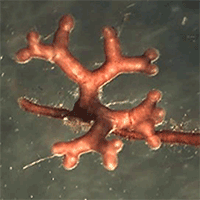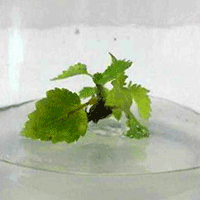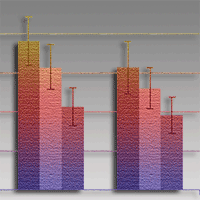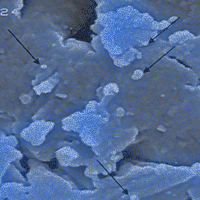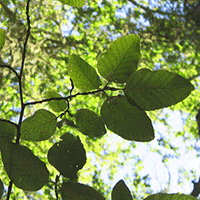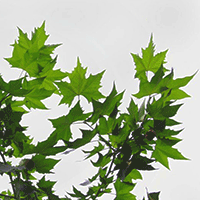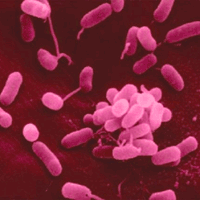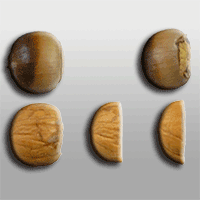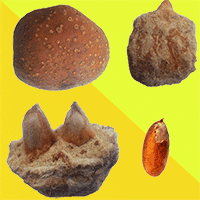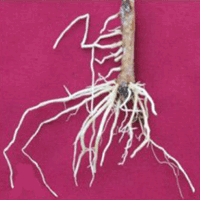Recent research points to the possibility of nanoparticles being used as fertilisers, growth stimulators, and promoters of plant resistance or pesticides. In this study, we sought to determine the influence of nanoparticles of silver and copper (AgNPs and CuNPs) on growth parameters and spontaneous mycorrhizal colonisation of roots in 2-year-old container-grown seedlings of Scots pine. Foliar applications of nanoparticles were made through two growing seasons, four times a season, at concentrations of 0, 5, 25 and 50 ppm. Comparisons of the ultrastructures characterising the needles, stems and roots of the treated or untreated pines were conducted with transmission electron microscopy (TEM). The deployed CuNPs stimulated mycorrhizal colonisation at all concentrations, although the growth of seedlings was only promoted at a concentration of 25 ppm. Higher concentrations of AgNPs (25 and 50 ppm) inhibited the formation of mycorrhizae, though the lowest concentration (5 ppm) produced an increase in both mycorrhizal colonisation and the dry mass of roots. The species of ectomycorrhizal fungi found were Thelephora terrestris, Suillus bovinus and Sphaerosporella brunnea. The TEM results comparing treated and control (untreated) needles revealed changes in the chloroplasts from lens-shaped to spherical. Furthermore, an increase in the number of plastoglobules and the presence of large osmophilic globules in the cytoplasm associated solely with the needles of pines receiving 50 ppm nanoparticles were observed. In contrast, ultrastructural changes in stems and roots associated with the applications of NPs were not found. Overall, the results indicated that CuNPs and AgNPs could be used as stimulators of growth in general, and mycorrhizal colonisation in particular, among container-grown Scots pines. However, further work is needed to determine their optimal doses and concentrations.
Keywords
, , ,
Citation
Aleksandrowicz-Trzcinska M, Szaniawski A, Studnicki M, Bederska-Blaszczyk M, Olchowik J, Urban A (2018). The effect of silver and copper nanoparticles on the growth and mycorrhizal colonisation of Scots pine (Pinus sylvestris L.) in a container nursery experiment. iForest 11: 690-697. - doi: 10.3832/ifor2855-011
Academic Editor
Claudia Cocozza
Paper history
Received: May 18, 2018
Accepted: Jul 22, 2018
First online: Oct 23, 2018
Publication Date: Oct 31, 2018
Publication Time: 3.10 months
© SISEF - The Italian Society of Silviculture and Forest Ecology 2018
Open Access
This article is distributed under the terms of the Creative Commons Attribution-Non Commercial 4.0 International (https://creativecommons.org/licenses/by-nc/4.0/), which permits unrestricted use, distribution, and reproduction in any medium, provided you give appropriate credit to the original author(s) and the source, provide a link to the Creative Commons license, and indicate if changes were made.

Breakdown by View Type
(Waiting for server response...)
Article Usage
Total Article Views: 46650
(from publication date up to now)
Breakdown by View Type
HTML Page Views: 38888
Abstract Page Views: 3541
PDF Downloads: 3280
Citation/Reference Downloads: 6
XML Downloads: 935
Web Metrics
Days since publication: 2634
Overall contacts: 46650
Avg. contacts per week: 123.97
Article Citations
Article citations are based on data periodically collected from the Clarivate Web of Science web site
(last update: Mar 2025)
Total number of cites (since 2018): 11
Average cites per year: 1.38
Publication Metrics
by Dimensions ©
Articles citing this article
List of the papers citing this article based on CrossRef Cited-by.
(1)
Agerer R (2008)Colour atlas of ectomycorrhizae (15th edn). Einhorn-Verlag, Schwäbisch Gmünd, Munich, Germany, 3 volls.
Gscholar
(2)
Aleksandrowicz-Trzcinska M, Grzywacz A (1997)The effect of fungicides used in the protection of forest tree seedlings on the growth of ectomycorrhizal fungi. Acta Mycologica 32 (2): 315-322.
CrossRef |
Gscholar
(3)
Bernhardt ES, Colman BP, Hochella MF, Cardinale BJ, Nisbet M, Richardson CJ, Yin L (2010)An ecological perspective on nanomaterial impacts in the environment. Journal of Environmental Quality 39: 1-12.
CrossRef |
Gscholar
(4)
Broekgaarden C, Caarls L, Vos IA, Pieterse CMJ, Van Wees SCM (2015)Ethylene: traffic controller on hormonal crossroads to defense. Plant Physiology 169: 2371-2379.
CrossRef |
Gscholar
(5)
Cao J, Feng Y, He S, Lin X (2017)Silver nanoparticles deteriorate the mutual interaction between maize (
Zea mays L.) and arbuscular mycorrhizal fungi: a soil microcosm study. Applied Soil Ecology 119: 307-316.
CrossRef |
Gscholar
(6)
Capuana M (2011)Heavy metals and woody plants - biotechnologies for phytoremediation. iForest - Biogeosciences and Forestry 4: 7-15.
CrossRef |
Gscholar
(7)
Central Statistical Office (2017)Statistical information and elaborations. Central Statistical Office, Zaklad Wydawnictw Statystycznych, Warsaw, Poland pp. 342.
Online |
Gscholar
(8)
Colpaert JV (1999)Thelephora. In: “Ectomycorrhizal fungi. Key genera in profile” (Cairney JWG, Chambers SM eds.) Springer, Berlin, Germany, pp. 325-245.
CrossRef |
Gscholar
(9)
Dahm H (2009)Bakterie towarzyszace mikoryzom i ich rola w funkcjonowaniu symbiozy [Bacteria associated with mycorrhizae and their role in the functioning of symbiosis]. Sylwan 153: 134-139.
Gscholar
(10)
Dahlberg A, Finlay RD (1999)Suillus. In: “Ectomycorrhizal fungi. Key genera in profile” (Cairney JWG, Chambers SM eds.) Springer, Berlin, Germany, pp. 33-46.
CrossRef |
Gscholar
(11)
Dubchak S, Ogar A, Mietelski JW, Turnau K (2010)Influence of silver and titanium nanoparticles on arbuscular mycorrhiza colonization and accumulation of radiocaesium in
Helianthus annuus. Spanish Journal of Agricultural Research 8: 103-108.
CrossRef |
Gscholar
(12)
Feng Y, Cui X, He S, Dong G, Chen M, Wang J, Lin X (2013)The role of metal nanoparticles in influencing arbuscular mycorrhizal fungi effects on plant growth. Environmental Science and Technology 47: 9496-9504.
CrossRef |
Gscholar
(13)
Ge Y, Schimel JP, Holden PA (2012)Identification of soil bacteria susceptible to TiO
2 and ZnO nanoparticles. Applied Environmental Microbiology 78 (18): 6749-6758.
CrossRef |
Gscholar
(14)
Högberg P, Högberg MN, Göttlicher SG, Betson NR, Keel SG, Metcalfe DB, Campbell C, Schindlbacher A, Hurry V, Lundmark T, Linder S, Näsholm T (2008)High temporal resolution tracing of photosynthate carbon from the tree canopy to forest soil microorganisms. New Phytologist 177: 220-228.
CrossRef |
Gscholar
(15)
Iwanski M, Rudawska M, Leski T (2006)Mycorrhizal associations of nursery grown Scots pine (
Pinus sylvestris L.) seedlings in Poland. Annals of Forest Science 63: 715-723.
CrossRef |
Gscholar
(16)
Jaberzadeh A, Moaveni P, Tohidi Moghadam HR, Zahedi H (2013)Influence of bulk and nanoparticles titanium foliar application on some agronomic traits, seed gluten and starch contents of wheat subjected to water deficit stress. Notulae Botanicae Horti Agrobotanici Cluj - Napoca 41 (1): 201-207.
CrossRef |
Gscholar
(17)
Josko I, Oleszczuk P (2013)Influence of soil type and environmental conditions on ZnO, TiO
2 and Ni nanoparticles phytotoxicity. Chemosphere 92: 91-99.
CrossRef |
Gscholar
(18)
Judy JD, Kirby JK, Creamer C, McLaughlin MJ, Fiebiger C, Wright C, Cavagnaro TR, Bertsch PM (2015)Effects of silver sulfide nanomaterials on mycorrhizal colonization of tomato plants and soil microbial communities in biosolid-amended soil. Environmental Pollution 206: 256-263.
CrossRef |
Gscholar
(19)
Karnovsky MJ (1965)A formaldehyde-glutaraldehyde fixative of high osmolality for use in electron microscopy. Journal of Cell Biology 27: 137.
Online |
Gscholar
(20)
Kashyap PL, Kumar S, Srivastava AK, Sharma AK (2012)Myconanotechnology in agriculture: a perspective. World Journal of Microbiology and Biotechnology 29 (2): 191-207.
CrossRef |
Gscholar
(21)
Krakau UK, Liesebach M, Aronen T, Lelu-Walter MA, Schneck V (2013)Scots Pine (
Pinus sylvestris L.). In: “Forest Tree Breeding in Europe” (Pques L ed). Managing forest ecosystems, vol. 25, Springer, Dordrecht, Netherlands, pp. 267-323.
CrossRef |
Gscholar
(22)
Lalau CM, Mohedano R, Schmidt EC, Bouzon Z, Ouriques LC, Dos Santos R, Da Costa CH, Vicentini DS, Matia WG (2014)Toxicological effects of copper oxide nanoparticles on the growth rate, photosynthetic pigment content, and cell morphology of the duckweed
Landoltia punctata. Protoplasma 252: 221-229.
CrossRef |
Gscholar
(23)
Leski T, Pietras M, Rudawska M (2010)Ectomycorrhizal fungal communities of pedunculate and sessile oak seedlings from bare-root forest nurseries. Mycorrhiza 20: 179-190.
CrossRef |
Gscholar
(24)
Linglan M, Chao L, Chunxiang Q, Sitao Y, Jie L, Fengqing G, Fashui H (2008)Rubisco activase mRNA expression in spinach: modulation by nanoanatase treatment. Biological Trace Element Research 122 (2): 168-178.
CrossRef |
Gscholar
(25)
Menkis A, Vasiliauskas R, Taylor AF, Stenlid J, Finlay R (2005)Fungal communities in mycorrhizal roots of conifer seedlings in forest nurseries under different cultivation systems, assessed by morphotyping, direct sequencing and mycelial isolation. Mycorrhiza 16: 33-41.
CrossRef |
Gscholar
(26)
McDaniel BK, Binder BM (2012)Ethylene receptor 1 (ETR1) is sufficient and has the predominant role in mediating inhibition of ethylene responses by silver in
Arabidopsis thaliana. Journal of Biological Chemistry 287 (31): 26094-26103.
CrossRef |
Gscholar
(27)
Nair PMG, Chung IM (2014)A mechanistic study on the toxic effect of copper oxide nanoparticles in soybean (
Glycine max L.) root development and lignification of root cells. Biological Trace Element Research 162: 342-352.
CrossRef |
Gscholar
(28)
Nel A, Xia T, Mädler L, Li N (2006)Toxic potential of materials at the nanolevel. Science 311: 622-627.
CrossRef |
Gscholar
(29)
Olchowik J, Bzdyk R, Studnicki M, Bederska-Blaszczyk M, Urban A, Aleksandrowicz-Trzcinska M (2017)The effects of silver and copper nanoparticles on the condition of English oak (
Quercus robur L.) seedlings in a container nursery experiment. Forests 8: 310.
CrossRef |
Gscholar
(30)
Plett JM, Khachane A, Ouassou M, Sundberg B, Kohler A, Martin F (2014)Ethylene and jasmonic acid act as negative modulators during mutualistic symbiosis between
Laccaria bicolor and
Populus roots. New Phytologist 202: 270-286.
CrossRef |
Gscholar
(31)
Pietras M, Rudawska M, Leski T, Karlinski L (2013)Diversity of ectomycorrhizal fungus assemblages on nursery grown European beech seedlings. Annals of Forest Science 70: 115-121.
CrossRef |
Gscholar
(32)
Piller LE, Abraham M, Dormann P, Kessler F, Besagni C (2012)Plastid lipid droplets at the crossroads of prenylquinone metabolism. Journal of Experimental Botany 63: 1609-1618.
CrossRef |
Gscholar
(33)
Raliya R, Tarafdar JC (2013)ZnO nanoparticle biosynthesis and its effect on phosphorous-mobilizing enzyme secretion and gum contents in Clusterbean (
Cyamopsis tetragonoloba L.). Agricultural Research 2 (1): 48-57.
CrossRef |
Gscholar
(34)
R Core Team (2012)R: a language and environment for statistical computing. R Foundation for Statistical Computing, Vienna, Austria, pp. 2630.
Online |
Gscholar
(35)
Rizwan M, Ali S, Qayyum MF, Ok YS, Adrees M, Ibrahim M, Zia-ur-Rehman M, Farid M, Abbas F (2017)Effect of metal and metal oxide nanoparticles on growth and physiology of globally important food crops: a critical review. Journal of Hazardous Materials 322: 2-16.
CrossRef |
Gscholar
(36)
Ruffini Castiglione M, Cremoni R (2009)Nanoparticles and higher plants. Caryologia 62 (2): 161-165.
CrossRef |
Gscholar
(37)
Schnitzer M, Hansen EH (1970)Organo-metallic interactions in soils: 8. An evaluation of methods for determination of stability constant of metal- fulvic acid complexes. Soil Science 109: 333-340.
CrossRef |
Gscholar
(38)
Selga T, Selga M (1996)Response of
Pinus silvestris L. needles to electromagnetic fields. Cytological and ultrastructural aspects. Science of the Total Environment 180: 65-73.
CrossRef |
Gscholar
(39)
Servin A, Elmer W, Mukherjee A, De la Torre-Roche R, Hamidi H, White JC, Bindraban P, Dimkpa C (2015)A review of the use of engineered nanomaterials to suppress plant disease and enhance crop yield. Journal of Nanoparticle Research 17: 92.
CrossRef |
Gscholar
(40)
Shaw AK, Hossain Z (2013)Impact of nano-CuO stress on rice (
Oryza sativa L.) seedlings. Chemosphere 93: 906-915.
CrossRef |
Gscholar
(41)
Smith SE, Read DJ (2008)Mycorrhizal symbiosis. Academic Press, Cambridge, UK, pp. 768.
Gscholar
(42)
Stenström E, Ek M (1990)Field growth of
Pinus sylvestris following nursery inoculation with mycorrhizal fungi. Canadian Journal of Forest Research 20: 914-918.
CrossRef |
Gscholar
(43)
Sweet MJ, Singleton I (2015)Soil contamination with silver nanoparticles reduces Bishop pine growth and ectomycorrhizal diversity on pine roots. Journal of Nanoparticle Research 17: 448.
CrossRef |
Gscholar
(44)
Tarafdar JC, Raliya R, Mahawar H, Rathore I (2014)Development of zinc nanofertilizer to enhance crop production in pearl millet (
Pennisetum americanum). Agricultural Research 3 (3): 257-262.
CrossRef |
Gscholar
(45)
Villeneuve N, Le Tacon F, Bouchard D (1991)Survival of inoculated
Laccaria bicolor in competition with native ectomycorrhizal fungi and effects on the growth of outplanted Douglas-fir seedlings. Plant and Soil 135: 95-108.
CrossRef |
Gscholar
(46)
Wang B, Qiu YL (2006)Phylogenetic distribution and evolution of mycorrhizas in land plants. Myzorrhiza 16: 299-363.
CrossRef |
Gscholar
(47)
Yamasaki H, Pilon M, Shikanai T (2008)How do plants respond to copper deficiency? Plant Signaling and Behavior 3: 231-232.
CrossRef |
Gscholar
(48)
Yang SF (1987)The role of ethylene and ethylene synthesis in fruit ripening. In: “Plant senescence: its biochemistry and physiology” (Thomson WW, Nothnagel LA, Huffaker RC eds). The American Society of Plant Physiology, Riverside, CA, USA, pp. 156-166.
Gscholar
(49)
Yang F, Liu C, Gao F, Su M, Wu X, Zheng L, Hong F, Yang P (2007)The improvement of spinach growth by nano-anatase TiO
2 treatment is related to nitrogen photoreduction. Biological Trace Element Research 119 (1): 77-88.
CrossRef |
Gscholar
(50)
Zarafshar M, Akbarinia M, Askari H, Hossein SM, Rahaie M, Struve D (2015)Toxicity Assessment of SiO
2 nanoparticles to pear seedlings. International Journal of Nanoscience and Nanotechnoogy 11 (1): 13-22.
Gscholar
